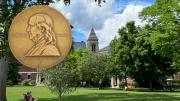The Supreme Court seemed to close a long, fraught chapter in American history in 1954 when it held that the Constitution prohibits every state from maintaining separate public schools for blacks and for whites. In Brown v. Board of Education, by a vote of 9-0, the justices called for an absolute end to a pervasive consequence of America’s racial divide. The ruling is often called the most important of the Court in the twentieth century; it is clearly the most important about school desegregation.
James Ryan, the new dean of the Harvard Graduate School of Education (GSE), argues persuasively that the second most significant ruling about school desegregation is Milliken v. Bradley, which the Court decided in 1974. The decision was momentous for the opposite reason: it halted the startlingly short-lived national effort to desegregate public schools, heavily segregated by race because of widespread segregation in housing.
The justices ruled, 5-4, that a metropolitan area could not desegregate a city’s largely black school district by consolidating it with largely white suburban districts and transporting students between them, unless there was proof that suburbs had deliberately devised separate schools for blacks and for whites or were otherwise liable for segregation across district lines. The majority said de jure segregation (caused by the state or a local government) was different from de facto segregation (resulting from social and economic factors, like lower housing prices in the city and white flight to the suburbs) and that it was constitutional to address only the first through a metropolitan-wide effort.
It is common among education reformers to describe the country’s current education crisis as “the civil-rights issue of our time.” For Ryan, that is literally so: the crisis stems from the failure to desegregate public schools after the Supreme Court would not let remedies for reform cross the line between city and suburbs, a fundamental divide of geography, race, and class.
He tells this far-reaching yet little-known story in Five Miles Away, A World Apart, published in 2010. It contrasts the experiences of the struggling Thomas Jefferson High School in Richmond, Virginia, and the thriving Freeman High School in the nearby suburb of Henrico County. Freeman was then 73 percent white and 75 percent middle class. TJ, as the other school is known, was 82 percent black and mostly poor. Students at the first easily exceeded Virginia’s academic standards on statewide tests. At the second, they struggled to meet them and didn’t see the point of the tests—even though the amount of money spent on the education of each student was notably higher at TJ.
The book explains that today’s crisis in American education in K-12 schools is predominantly a crisis of the bottom 30 percent, with students from low-income families in urban schools lagging badly behind students from middle-income and wealthier families in suburban schools in every measure: test scores, graduation rates, and rates of going to college. But the isolation of low-income minority students in cities (and increasingly of low-income black and Latino students in racially segregated and isolated suburban schools) means that middle-class and wealthier white suburban students are also isolated, at a measurable cost.
In an increasingly diverse nation, a substantial body of scholarship shows, it is best for students of all races, ethnicities, and backgrounds to learn from each others’ points of view. Students in integrated schools are more tolerant and less prejudiced, measured by the tendency to accept and connect with people of other races versus holding them at a distance and turning them into negative stereotypes. They are more likely to want to go to integrated colleges, live in diverse neighborhoods, and work with people from different backgrounds.
Since the Milliken ruling, there has been a vast effort to improve public education for students from kindergarten through high school with an extensive range of reforms. These include substantial spending to boost student achievement in urban schools, networks of charter schools as alternatives in urban public districts, and academic benchmarks on standardized tests for schools as well as students.
From his sweeping research, however, Ryan concluded that only one reform would make a sea change of difference in the overall performance and development of American students. That reform would mandate the most ambitious kind of integration: with students of different classes and races, from cities and adjacent suburbs, transported across district lines to go to school together.
This kind of integration makes schools more likely to have the elements that improve academic achievement, Ryan wrote: “strong principals, talented and engaged teachers, reasonable class sizes, a rich curriculum, high expectations on the part of students and teachers alike, adequate facilities, and active parents.” Such integration can also “bring political benefits and greater accountability,” through “a critical mass of active and engaged parents” who are “more likely to have the clout to fight successfully for resources,” to monitor “principal and teacher performance,” and contribute to the effectiveness of their child’s school.
A student from a poor family is much more likely to succeed academically in a school filled mostly with middle-class students than in one filled mostly with lower-income students. And students from middle-income families maintain their achievement when they go to school with students from poor families, if the school maintains a majority of middle-class students.
“The same is true for racial integration,” Ryan wrote. “The socioeconomic composition of a school matters more to academic achievement than the racial composition.” But to “give up entirely on racial diversity,” he went on, “is to accept the narrowing of expectations for public schools….”
That narrowing refers to a focus solely on academic goals, with the abandonment of civic goals—like fostering ties that bind Americans as “We the People.” Integration allows schools to fulfill a civic mission, seeking to teach students not only reading, writing, and arithmetic, but also how to be better citizens. In the twenty-first century, Ryan wrote, that must include “understanding and friendship across lines of class and race.”
Ryan, who is 47, is a sterling example of what can happen when talent and drive are empowered by family and fine teachers. He grew up in a blue-collar family in New Jersey, where his father worked for the telephone company, repairing phone lines and then supervising repair crews, and his mother was a bookkeeper. Neither went to college, but they insisted there was no limit to what he could accomplish. Teachers of his in public schools reinforced that message. With a scholarship and other financial aid, he went to Yale, graduating summa cum laude and Phi Beta Kappa in 1988.
He took a gap year after college—playing rugby on a team made up of New England college players who toured New Zealand and Australia; working as a children’s ski instructor in Colorado; and, in rural Kentucky, spending a couple of months volunteering, through Catholic Charities, in a group home for disabled kids.
On a full merit scholarship, Ryan went to the University of Virginia Law School, where he continued to play rugby and graduated first in his class in 1992. He clerked for Chief Judge J. Clifford Wallace of the United States Court of Appeals for the Ninth Circuit and for Chief Justice William Rehnquist of the Supreme Court, and worked for two years as a public-interest lawyer in New Jersey, on a landmark case in state court about increasing funding for poor school districts.
Since joining the University of Virginia’s law faculty in 1998, Ryan has focused on how American law and politics have shaped education and opportunity during the past half-century, often impeding or undermining the progress they were intended to bring about. His work has been about root causes and basic solutions, removed from ideology. He was honored as one of the university’s best teachers, and has also won a national reputation, as Yale Law School’s James Forman Jr. has described it, “as the best scholar in this niche of legal scholarship.”
Forman co-founded the Maya Angelou Charter School, in Washington, D.C.; he and Ryan served together as members of its board of trustees. The school, started for young people who had been in the juvenile justice system, now also teaches former dropouts and students needing special education. They are mostly black and from low-income families.
“How much is Jim Ryan willing to roll up his sleeves and help solve nitty-gritty problems?” Forman asked, and answered: “He analyzed school data to help the school figure out how to boost the attendance rate of students who were chronic no-shows.” The school gave points to students who showed up, and rewards for points accrued, like a day’s exemption from having to wear the school uniform.
Harvard president Drew Faust said she heard “a chorus of acclaim” when she spoke with people in education about Ryan as a candidate for dean. His belief that his life was transformed by the opportunity he had to get a great college education is “all but inseparable,” she emphasized, from his passion for helping provide similar opportunities for young Americans without great means. She is excited by his excitement that being dean puts him in a position, as being a law professor has not often done, to help solve fundamental problems in education.
The GSE’s focus is on the intersection of scholarship, policy, and practice. Ryan’s mandate includes continuing to build its two doctoral programs: its recent, highly sought-after one in education leadership, which is training leaders for school districts, government agencies, and other key organizations in how to apply current effective policies and practices; and its new, cross-disciplinary program in education research, which in the fall of 2014 will begin training future scholars, policymakers, and others in how to develop more effective policies and practices.
His most recent research, an example of the latter, explores why special education in America’s public schools must change because of compelling lessons from neuroscience. The main federal law governing this area of education assumes that learning disabilities are internal—caused, for example, by an injury to the brain. The law does not cover learning problems resulting from external sources, like growing up in poverty.
Meanwhile, the learning disabled make up 5 percent of the country’s public-school students, but draw more than 20 percent of all education spending—more than $100 billion. Experts have been calling for wholesale reform of this field; it is common for them to assert that special education costs too much because it covers too many young people.
Ryan’s view is the opposite. He argues that “the distinction between internal disorders and external circumstances is increasingly untenable” because the severe stress from living in poverty “can cause learning problems in much the same way that a brain injury or lead poisoning—which are explicitly included as bases for special education eligibility—can cause learning problems.”
Not all poor children are learning disabled, he emphasizes, but millions of school-aged children now living in poverty are not among the 6.6 million students enrolled in special education. There “is not yet a smoking gun” linking socio-economic status to brain function or structure and to deficits in thinking, but he lays out evidence about strong correlations between poverty and learning difficulties that “provide converging strands of proof.” In his view, many students who are poor and struggling in school should be covered by special education because of the damaging effects of “toxic stress.” He quotes the words of the neuroscientist Martha Farah: “Growing up poor is bad for your brain.”
As Ryan and the GSE look for fresh, far-reaching ways to close the opportunity gap for young Americans, Five Miles Away, A World Apart will be germane, even though integration is not a priority in education for either the Democratic or Republican parties. The book presents a brief for what would be most effective in improving American education, but also for what Ryan believes is compelled by justice, despite the Supreme Court’s reversal between its decisions in Brown and Milliken and the harshly diminished aspirations that followed.
“Equal educational opportunity is a foundational principle of our society,” he has written, yet educational opportunities “are far from equal in this country and too often depend on where students live, on how much money their parents earn, or on the color of their skin.” The nub of his book’s conclusion is that “separating the poor and politically powerless in their own schools and districts is antithetical to the idea of equal educational opportunity.” Anyone who deals with Ryan as dean will be much better prepared if they understand this deep-seated conviction and how it shapes his ambition for American education.









